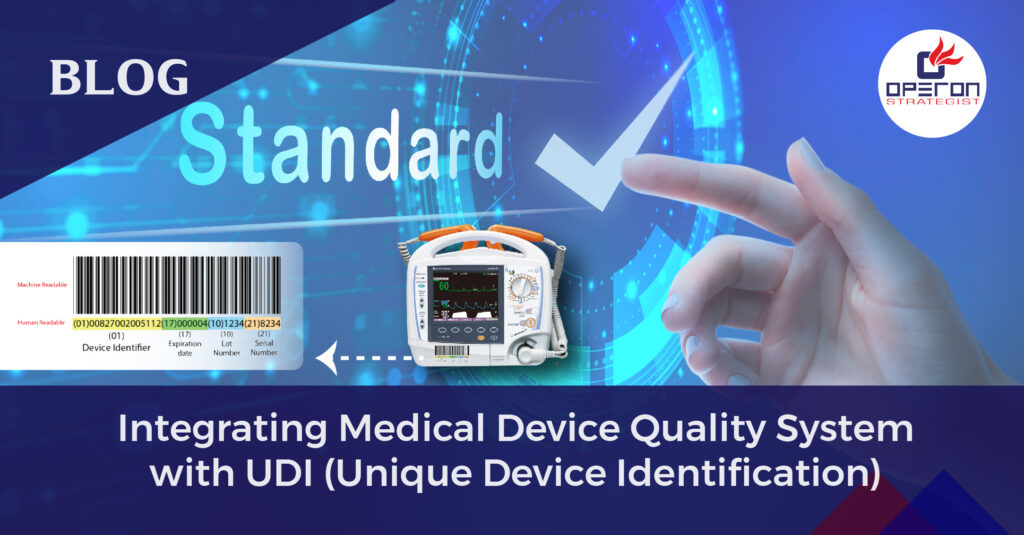As medical device regulation continues to change, it is more important than ever to ensure patient safety and product traceability. A system called Unique Device Identification (UDI) was developed with the goal of enhancing the efficiency of the medical device supply chain overall while also enhancing patient safety and post-market surveillance. Understanding how to include UDI into your quality system is essential if you produce medical devices.
Our team crafts tailored strategies to integrate UDI into your quality system while aligning with your business objectives.
The Significance of Unique Device Identification (UDI)
UDI is a system introduced by the United States Food and Drug Administration (FDA) as part of its efforts to improve patient safety, traceability, and post-market surveillance of medical devices. UDI requires manufacturers to assign a unique identifier to each medical device model or version distributed in the market. The identifier consists of two main components:
- Device Identifier (DI): This part identifies the specific device model, including its version or model number, production date, and expiration date.
- Production Identifier (PI): The PI provides information about the unit’s lot or batch number, serial number, and manufacturing date.
By incorporating UDI into your quality system, you not only comply with regulatory requirements but also gain valuable data for post-market surveillance, recalls, and adverse event reporting. Additionally, UDI can improve inventory management, supply chain efficiency, and overall product traceability, reducing the risk of counterfeit or substandard devices entering the market.
Integrating Medical Device Quality System with UDI
Step-by-Step process for QMS for Medical Device with QMS
- Familiarize Yourself with UDI Requirements: Before diving into integration, it is crucial to understand the specific UDI requirements applicable to your medical devices. These requirements can vary based on the device class as per Quality Management System, regulations in different regions, and whether the device is intended for single-use or reusable.
- Identify UDI Implementation Timelines: UDI compliance deadlines may differ depending on your device’s classification and whether it is already on the market or is still in the development phase. Be aware of the timelines to ensure a smooth integration process.
- Review Your Current Quality System: Assess your existing quality system to identify areas that need adjustment to accommodate UDI requirements. Pay attention to processes related to device labeling, documentation, data management, and post-market surveillance.
- Select an Approved Issuing Agency: As a manufacturer, you need to work with an FDA-accredited issuing agency to obtain a UDI for your devices. The issuing agency will provide you with a unique code for each device, ensuring consistency and compliance.
- Incorporate UDI into Device Labels and Packaging: Modify your device labels and packaging to include the UDI in both human-readable and automatic identification and data capture (AIDC) formats. The AIDC format typically involves barcodes or QR codes, enabling easy scanning and data capture throughout the device’s lifecycle.
- Update Device Databases and Records: Integrate the UDI information into your internal databases, records, and electronic systems. This will facilitate efficient tracking, reporting, and retrieval of device-related data when necessary.
- Train Personnel: Properly educate your employees about UDI integration and its significance within the quality system. Ensuring that your team is well-versed in UDI implementation will help maintain compliance and streamline daily operations.
- Implement Post-Market Surveillance and Reporting: UDI enables better tracking of devices and faster identification of potential issues, leading to prompter reporting and appropriate actions if adverse events occur.
Leveraging UDI data for post-market surveillance is vital for patient safety and regulatory reporting. We help you optimize your surveillance processes to stay proactive and compliant. - Regularly Review and Update UDI Data: As your medical device evolves and new versions are released, ensure that the UDI data is consistently updated and maintained accurately across all relevant documentation and systems.
Integrating Unique Device Identification (UDI) into your medical device quality system is not only a regulatory obligation but also a strategic opportunity to enhance patient safety and supply chain efficiency.
With Operon Strategist as your trusted medical device regulatory consultants, integrating your Quality System with UDI (Unique Device Identification) becomes a seamless journey towards enhanced compliance, traceability, and patient safety. Contact us today to get started on your project and ensure a seamless manufacturing process of medical devices
By following the steps outlined above and embracing UDI as an integral part of your quality management processes, you can navigate the evolving regulatory landscape with confidence while contributing to a safer and more reliable healthcare ecosystem. Embrace UDI as a tool for continuous improvement and a commitment to patient well-being.

-
Operon Strategisthttps://operonstrategist.com/author/snehal/
-
Operon Strategisthttps://operonstrategist.com/author/snehal/
-
Operon Strategisthttps://operonstrategist.com/author/snehal/
-
Operon Strategisthttps://operonstrategist.com/author/snehal/




